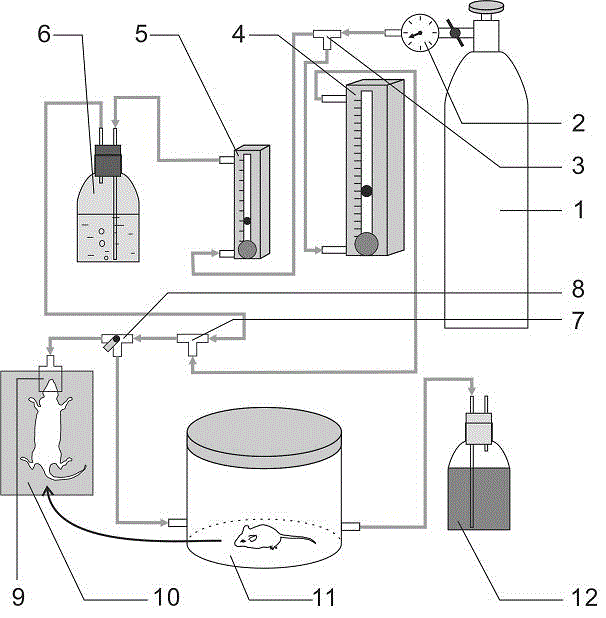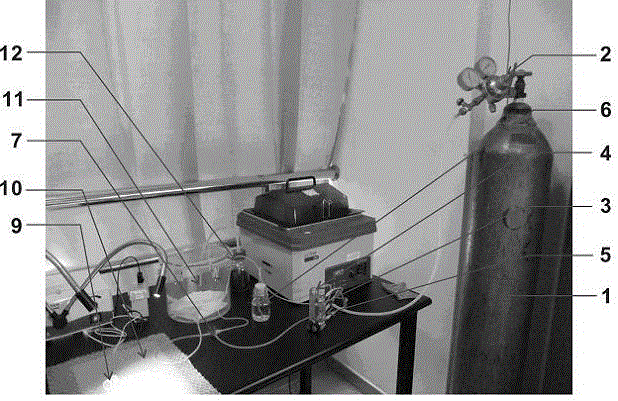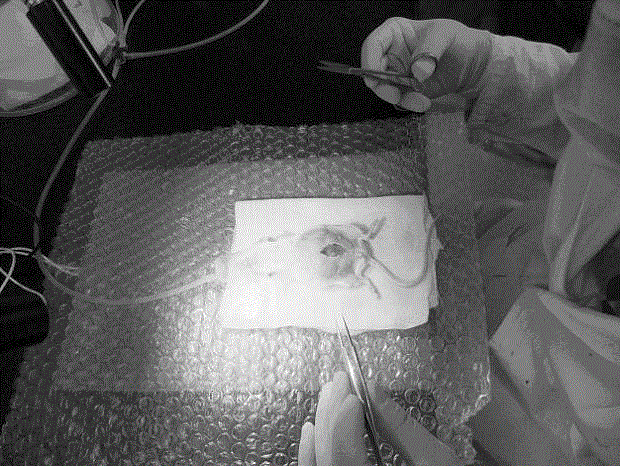Simple small animal inhalation anesthesia machine
A technology for small animals and anesthesia machines, applied in medical science, veterinary instruments, etc., can solve the problems of low morbidity and mortality of small animals, high dependence on small animal anesthesia machines, and high prices of imported anesthesia machines, and achieve good promotion. Sexuality, efficient anesthesia effect, and the effect of reducing the expenditure of funds
- Summary
- Abstract
- Description
- Claims
- Application Information
AI Technical Summary
Problems solved by technology
Method used
Image
Examples
Embodiment 1
[0040] Such as figure 1 As shown, this simple and economical small animal inhalation anesthesia machine consists of a gas cylinder 1, a gas regulating valve 2, a three-way pipe I3, a gas flowmeter I4, a gas flowmeter II5, an isoflurane gas volatilization bottle 6, and a three-way pipe II7 , an adjustable three-way pipe 8, an anesthesia mask 9, an animal body temperature constant temperature system 10, an anesthesia induction box 11 and a gas recovery bottle 12;
[0041] The gas cylinder 1 is sequentially connected to the gas regulating valve 2 and the three-way pipe I3, one end of the three-way pipe I3 is connected to the gas flowmeter I4, and the other end is connected to the gas flowmeter II5, and the gas flowmeter II5 is connected to the different The halothane gas volatilization bottle 6, the other conduit of the isoflurane gas volatilization bottle 6 is sequentially connected to the three-way pipe II7 and the adjustable three-way pipe 8, one end of the three-way pipe II...
Embodiment 2
[0049] Example 2 In vivo virus injection experiment in mouse ventricle
[0050] Such as image 3 As shown, in this example, in vivo virus injection experiments were performed on embryonic mice on day 13 of pregnancy. The pregnant mice were pre-anesthetized in an anesthesia induction box, and then the anesthetized mice were placed on a small animal thermostat (maintained at 37 ~39°C) and use a gas anesthesia hood to continuously anesthetize the surgical mouse; the total gas flow (L) should be adjusted within the range of 1L, and the gas ratio of isoflurane (L Ratio ) should be controlled within 20-30%; during the operation, closely observe the respiratory rate of the operated mice to ensure that the respiratory rate is 30-40 times / min.
[0051] The experimental results of this example show that under the above anesthesia conditions, mice can be stably and safely anesthetized for up to 3 hours. After the experiment, the anesthetized mice could wake up quickly within 5 minute...
Embodiment 3
[0052] Example 3 In vivo virus injection experiment in mouse ventricle
[0053] Such as Figure 4 As shown, in this example, an in vivo virus injection experiment was performed on the embryonic tree shrew at 34 days pregnant. The pregnant tree shrew was pre-anesthetized in the anesthesia induction box, and then the anesthetized tree shrew was placed on a small animal constant temperature pad (maintained at 37 ~39°C) and use a gas anesthesia mask to continuously anesthetize the surgical tree shrew; the total gas flow (L) should be adjusted within the range of 1.5L, and the gas ratio of isoflurane (L Ratio ) should be controlled within 20-30%; during the operation, closely observe the respiratory rate of the surgical tree shrew to ensure that the respiratory rate is 30-40 times / min.
[0054] The experimental results of this example show that under the above-mentioned anesthesia conditions, tree shrews can be stably and safely anesthetized for up to 3 hours. After the experim...
PUM
 Login to View More
Login to View More Abstract
Description
Claims
Application Information
 Login to View More
Login to View More - R&D
- Intellectual Property
- Life Sciences
- Materials
- Tech Scout
- Unparalleled Data Quality
- Higher Quality Content
- 60% Fewer Hallucinations
Browse by: Latest US Patents, China's latest patents, Technical Efficacy Thesaurus, Application Domain, Technology Topic, Popular Technical Reports.
© 2025 PatSnap. All rights reserved.Legal|Privacy policy|Modern Slavery Act Transparency Statement|Sitemap|About US| Contact US: help@patsnap.com



